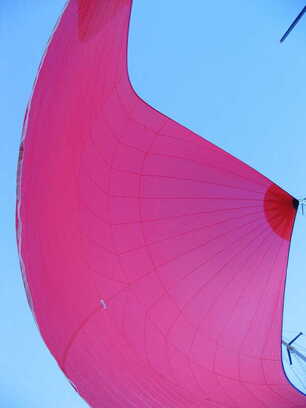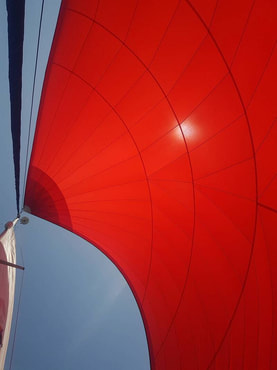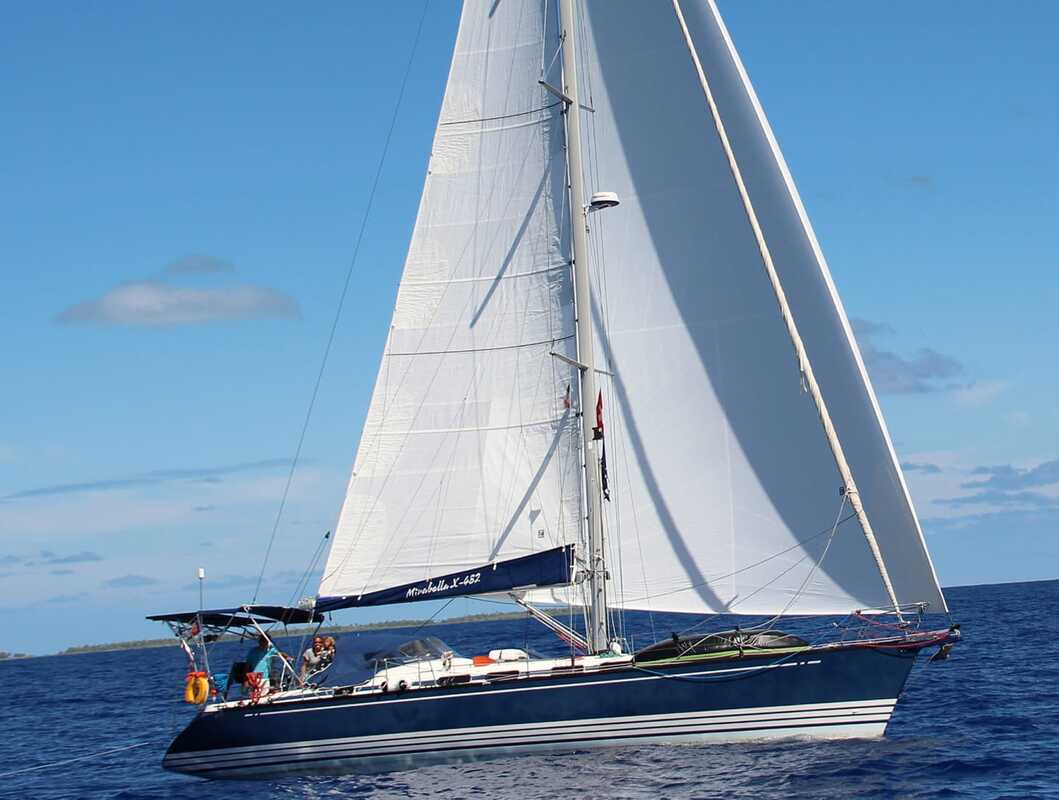|
In this article we will look into some of the common downwind options for blue water cruising sails, and offer some advice on the advantages and disadvantages for each type of sail. Symmetrical SpinnakersThe classic downwind sail is the Symmetrical spinnaker. This sail is the same length on both long edges ( leeches ) and the aerofoil shape built into the sail is symmetrical, so it can be gybed by simply rotating the sail to the other side of the boat. The disadvantage of being a symmetrical aerofoil is it isn't as efficient when reaching, but this doesn't mean it can't sail the same angles as a Asymmetrical sail of the same entry angle and depth. Generally spinnakers are flown from a spinnaker pole to add stability, control and extra speed. They can be flown without a pole on catamarans or trimarans where they can be tacked onto each outer bow. We've also seen them flown from the bow of a mono-hull with a soft strap around the furled up genoa in light airs. The design scope is quite large, and for cruising they don't have to be maximum size and can also be made easier to trim though shaping. The Para-Sailor type sail is a Symmetrical spinnaker with a cut out and wing in the center which acts like a soft batten, thus making the sail more stable. The cut out also helps to dampen the effect of gusts. The marketing on these sails is a little over the top, but they do offer some advantages to the cruising sailor over the traditional spinnaker. One of our customers who has both on his 50ft catamaran said "It isn't any easier, but it is more stable in high winds". Traditionally cruising spinnakers have been made from Nylon ranging from 0.5oz to 2.5oz. For cruising a snuffer sock is often added to make hoisting and dropping safer and easier. The advantages of a Symmetrical spinnaker are speed downwind - they project a large amount of sail area. They are versatile when used with a rotating pole, but the pole requires a downhaul and uphaul to keep it stable so there is a lot of rigging involved. Reaching they also project a large area, but the shape of the sail is not as efficient as an Asymmetrical sail. Asymmetrical SpinnakersAsymmetrical spinnakers started becoming more popular in the mid 90's and have become the most common downwind cruising sail. The luff on a asymmetrical spinnaker is longer than the leech and the foil shape is asymmetrical allowing more efficient reaching when the wind is flowing over both sides of the sail. Asymmetrical spinnakers can be flown from a pole off the mast just like a spinnaker, but are generally tacked onto the bow, or flown from a bowsprit. On Catamarans they can be tacked to the windward bow to allow running at deeper angles when used together with the mainsail. When tacked onto the bow of a mono-hull, if you are sailing too deep downwind, the sail will lose the wind as it comes into the wind shadow of the mainsail. Some cruisers prefer to sail without the mainsail which allows running dead downwind. On faster boats a zig zag course can become a faster way to sail downwind as the boat brings the apparent wind forward. But on most cruising cats and mono-hulls it is still faster to go with the wind, if that is the direction of your destination. Asymmetrical spinnakers can also be varied in size, width and design based on the type of boat, and the type of cruising. As with symmetrical spinnakers the fabric used is normally Nylon, and for cruising ranges from 0.75oz to 2.5oz Asymmetrical spinnakers for cruising have traditionally been paired with snuffer socks for hoisting and dropping. In the last few years top down furlers have started to become popular. The top down furler works by allowing the tack of the sail to swivel and wrapping the sail around a soft torsion rope from the head down. An asymmetrical spinnaker purposely designed for furling will have softer corners, and a flatter cut, but it is still okay to retrofit an old sail to a top down furling unit. The advantages are it is easier to setup tacked onto the bow, without a pole off the mast. They can be used with a furler, although some people still prefer the sock. They are fast reaching, but can't go dead downwind when tacked on the center line and the mainsail is hoisted. Cruising Code Zero and ScreecherIn the last few years the Cruising Code Zero's have been growing rapidly in popularity. These sails are not as big in size as spinnakers or as fast beam reaching and running, but are versatile and easy to handle for the cruising couple or family. They are also made of more durable and slighter heavier material than a spinnaker and work on furlers with a soft torsion rope inside the luff of the sail. Code Zero's are still made from a variety of fabric options from different sailmakers. We prefer a ripstop polyester which offers better performance and UV resistance than Nylon, while being more durable and longer lasting compared to the laminated cloth options available. Code zeros are at their best reaching forward of the beam, but also work well beam to broad reaching and can be poled out downwind to give maximum projected area and stability. A screecher is a term that comes from multi-hulls and is a similar sort of sail/concept. With their increased righting moment catamarans are able to carry these sort of sails in higher wind strengths, so the sails are a little heavier built, and in some cases are used to increase performance to windward in light airs, which requires a flatter cut. Drifter is also a term that should be mentioned, as these were similar to what we call a cruising code zero now a days. They are a big light air polyester genoa, that was generally either hanked onto the forestay or an extra stay in front of the forestay. The advantages of the code zero style sails are that they are more durable and forgiving than a spinnaker, easier to trim with the straight luff and internal torsion rope. Disadvantages are they can become heavy on bigger boats, and because the size is not as great as a spinnaker they are not as fast deeper reaching or running . Twizzel rig and other wing/wing downwind optionsThe twizel rig has been around for at least 50 years and is still an option for people sailing trade wind routes. Basically it is twin identical head sails, with one out each side and used without a mainsail. One or two poles add stability and you have a pretty durable downwind setup for medium to strong winds. In recent times this option has moved to twin furling headsails, so both sails can be reduced in size from the cockpit. You can also sail with both sails on the same side if needed. A recent variation of this concept, has been to make twin code zeros flown from an endless line furler and soft stay. This offers advantages in light airs, where you can increase the sail area over more traditional headsails, but you lose the ability to reef, as it is either all the way in or out. But it does also give you a code zero, as you can fly both sails together on one side for reaching We have also seen twizzel style setups with sails on different stays, either a large staysail or solent and the genoa, or even a code zero and a genoa. Sailing downwind without the mainsail, the boat is actually quite well balanced with the center of effort further forward, and the tendency to round up reduced. As a boat comes further off the wind, the center of effort of the sails needs to be further forward to balance the boat. That said there is nothing wrong with the standard working sail setup of mainsail with preventer and poled out genoa. A lot comes down to personal preference and what you are used to, and comfortable with. I hope you enjoyed this article. For future articles and updates, please like our facebook page.
|
|
Proud supporter of Sea Shepherd
|















